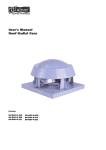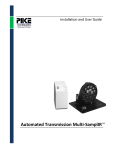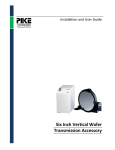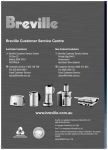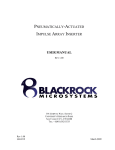Download 1 USER`S MANUAL - PNEUMATIC SPRAY GUN FOR SEALING
Transcript
USER’S MANUAL - PNEUMATIC SPRAY GUN FOR SEALING COMPOUNDS model PM/2 series 010 PARTS LIST: 1-PUMPING CHAMBER 2-REAR NUT 3-HANDLE 4-AIR FLOW REGULATOR 5-COMPRESSED AIR INLET (M1/4) 6-RELEASE TRIGGER 7-HEAD NUT 8-SPRAY HEAD 9-ADJUSTMENT KNOB FOR AIR INFLOW TO HEAD 10-NEEDLE ADJUSTMENT KNOB 11-PUMPING-OUT HEAD 12-ROUND PUMPING-OUT NOZZLE /2 pcs./ 13-FLAT PUMPING-OUT NOZZLE 14-TRIANGULAR PUMPING-OUT NOZZLE 15-310ml CARTOUCHE 16-HANGER 17-NEEDLE SEAL 18-FRONT NUT 19-PUMPING CHAMBER COMPRESSED AIR CONNECTION GENERAL WARNINGS This symbol draws your attention to issues involving your safety. Read them carefully and strictly follow them. Before you start using the spray gun, read its instructions for use thoroughly and follow its guidelines. Cut off the spray gun compressed air supply before carrying out any service or maintenance works. Contact your supplier or any service centre before carrying out any service or maintenance works, otherwise the product warranty will be rendered invalid. When selecting and before using the product to be sprayed with the spray gun, make sure that it complies with the intended use of the spray gun, and apply personal protective measures according to the product Material Safety Data Sheet (MSDS). Never turn the spray gun outlet towards yourself, other people, animals, and/or objects other than those, which are to be sprayed. While using the spray gun, wear suitable personal protective equipment (safety gloves, goggles, face guards, overalls, etc.), according to the instructions provided in sprayed product Material Safety Data Sheet. It is always recommended to wear safety goggles. When the spray gun is not to be used for some time, hang it on a special holder. 3. PACKAGING AND STORAGE The spray gun is delivered in a single cardboard box sized: 400 x 230 x 11 mm. Total weight is 1.8 kg, net weight = 1.6 kg. The device should be stored in a non-humid environment at the temperature ranging from -15°C to +40°C. 4. THE SPRAY GUN START-UP Ciśnienie robocze = Working pressure 3-4 bar Reduktor z filtrem = Reducer with a filter Min. przepływ powietrza = Min air flow 200 l/min Zawór = Valve Max. długość przewodu = Max. hose length 10 m Minimalna średnica wewnętrzna = Minimum inside diameter φ 6 mm 4.1 Connection to compressed air source taking into account the following characteristics 4.1.1 4.1.2 4.1.3 4.1.4 4.1.5 4.1.6 Approximate air consumption ranges from 200-300 l per minute. Working pressure: 3-5 bar. Maximum working pressure: 10 bar. Recommended length of the supply hose: 10 m. Minimum inside diameter of the supply hose: 6 mm. Air supply line connection to the spray gun - M1/4” tip. The use of the following elements should be taken into account in the air supply installation: reducer, filter, and cut-off valve. 4.2 CARTOUCHE LOADING 1 2 4.2.1 which remove Undo the rear nut of the pumping chamber anticlockwise. The rear nut is equipped with the rotary compressed air terminal, allows the support to be unscrewed without the need to remove the supply hose. Open the cartouche in the following way: the aluminium cartouche bottom cover, and then puncture its threaded end. Proceed carefully so as not to damage the threaded end and bottom orifice of the cartouche. Always check the expiration date of the product being used. of the Never insert a damaged cartouche into the pumping chamber. Even a minor distortion may result in the improper functioning spray gun and lead to its internal channels becoming blocked due toa hardening of the product left in them. 4.2.2 Insert the cartouche into the pumping chamber without fixing it /front nut of the chamber has no thread, which allows aluminium and plastic cartouches provided with various threads to be used/. 4.2.3 Tighten up the pumping chamber rear nut well, clockwise, so as to obtain the proper tightness between the cartouche and the pumping chamber gasket. 4.3 THE SET OF PUMPING OUT HEAD AND PLASTIC NOZZLES 4.3.1 Unscrew spraying head /8/ anticlockwise. 4.3.2 Put aside the spraying head /8/ and replace it with pumping out head /11/ with the external thread provided for the fixing of pumping out heads. 4.3.3 Fix pumping out head /11/ with head nut /7/ to the spray gun, turning it clockwise. 4.3.4 Choose pumping out nozzle /12, 13, 14/ to match the type of work, and screw it onto the head /11/ clockwise. Cut off the air supply to the head /9/ while the device works in the pumping out mode. 5 DEVICE CHARACTERISTICS 5.1 5.1.1 5.2.2 5.2.3 Intended use. Spraying and pumping out of polyurethane and polymer sealants from cartouches with any thread type. Always use the spray gun in an environment adapted for this type of work. When selecting a sealant type, make sure that the product is suitable for application by spraying. 5.2 5.2.1 5.2.2 Prohibited use of the device. It is prohibited to use any other product packaging types, than those specified before. It is forbidden to use containers with other products to be sprayed than those specified before. Read information contained in the product Material Safety Data Sheet to make sure that it is suitable for the spraying equipment used /its spraying elements, filters, etc./, and that user’s protective equipment will guarantee its safe use. 6 NOISE LEVEL Equivalent acoustic pressure level calculated according to scale A at a horizontal distance of 50 cm. For sealing products it is less than 80 dBA during spraying. 7. SPRAY GUN OPERATION 7.1 7.2 7.3 on 7.4 12/. Cartridge loading /see par. 4.2/. Compressed air connection - see par. 4.1. Press release trigger /6/ and turn the spray gun towards the proper object, changing the distance from 10 to 30 cm /depending operation results/. When you finish work with the spray gun, cut off the compressed air supply and hang the device on a special hook /see par. 8. ADJUSTMENT 8.1 Spray adjustment Keep turning the air inflow adjustment knob /9/ clockwise to gradually change the volume of air flowing in the head /spraying reduction/. The reverse operation allows spraying to be increased. Never exceed the initial setting during adjustment, because the air pressure may suddenly recoil the adjustment knob. Never exceed the extreme position /marked with a black seal/ while unscrewingt the knob. 3 8.2 Product volume adjustment Keep turning the needle adjustment knob /10/ clockwise to obtain a gradual product flow reduction. The reverse operation will increase the volume of material flowing out. 8.3 Adjustment of total flowing in air volume This operation is executed by the air flow regulator /4/. Turning it anticlockwise will cause the flow to increase, while the reverse operation will reduce the flow until it is completely cut off. 8.4 Combined adjustment Combined adjustment with knobs 9 and 10 and the air flow regulator /4/ allows a diversified area to be obtained, depending on the required effect. Adjustment with knobs is insufficient to obtain a specific effect /ribbing/, it is also required to select a suitable distance /see par. 7.3/. 9. HAZARDS 9.1 A fire hazard may occur depending on the type of product being used. Therefore, avoid smoking and using open fire during work with a potentially flammable product. 9.2 There is the possibility of the adjustment knob becoming recoiled, therefore never exceed the extreme position while unscrewing the knob. 10. PROBLEM SOLVING PROBLEMS REASONS WHAT TO DO The spray gun doesn’t work in spite of the released trigger. Air supply source is not connected. Open air flow regulator /4/, or change the settings of the knob for adjustment of air the inflow to the head /9/. Uneven spraying. Device elements, including internal channels, head, or nozzle, may be soiled or blocked. Clean internal channels, head and nozzle. Hardened product inside the spray gun elements. Too long a break in using a loaded spray gun, or nozzle and needle damage. Clean the spray gun, replace damaged parts. 11. MAINTENANCE 11.1 11.2 11.3 11.4 11.5 11.6 Cut off the spray gun from the compressed air supply source. Remove the cartouche from the pumping chamber. Pour the solvent into the pumping chamber. Leave the solvent in the chamber for a few minutes. Tighten up the rear nut /2/ and connect the compressed air supply source to the spray gun. Activate the spray gun to remove the solvent, directing it to a special container. Repeat this operation until the spray gun is thoroughly cleaned. Make sure that the adjustment knob /9/ is fully closed to prevent spraying the solvent into the environment. Do not dip the whole spray gun in the solvent, use a paintbrush or brush for cleaning. 11.7 If it happens that the product leaks within the needle seal /17/ area, immediately clean the elements and screw down the choking screw clockwise in order to make it tighter. This should prevent further product leaking. Finally, make sure that the needle moves freely. 11.7.1 If needed, lubricate the needle at the choking screw level. 11.7.2 It is required to lubricate the air valve stem from time to time. A clogged spray gun may cause container cartridge damage. Always keep nozzles clean. 12. BREAKS IN THE SPRAY GUN OPERATION The spray gun is hermetically closed, which means that its tightness is obtained owing to the use of the needle and nozzle on one side, and on the other side it is ensured by the cartouche inside the pumping chamber. The cartouche should always be kept in the container during any breaks in the spray gun operation to maintain the tightness of the device; otherwise the spray gun must be immediately cleaned. The device should be cleaned immediately at the end of working and in the case of extended breaks in usage. As a result of product hardening inside the spray gun, its elements will be blocked and, consequently, damaged. The cartouche may be left inside the pumping chamber for no longer than one or two days in the case of cartridges with polyurethane sealant / products quickly hardening, in particular in contact with moisture/. The cartouche may be left inside the pumping chamber for no longer than eight to ten days in the case of polymer sealants / slowhardening products/. 13. WARRANTY The quality of delivered products is covered by warranty. Each element found defected by our Technical Department will be replaced free of charge provided that it is has not been damaged due to faulty operation, soiled, and has been delivered by paid mail to our workshops. 4 5






